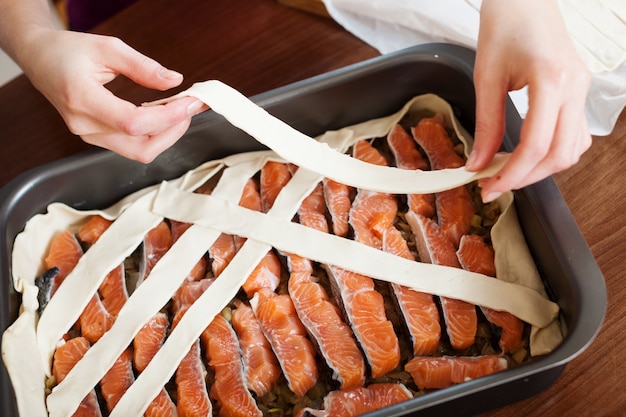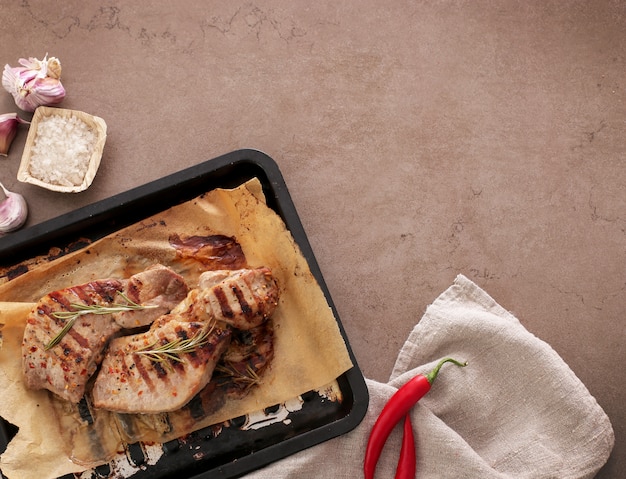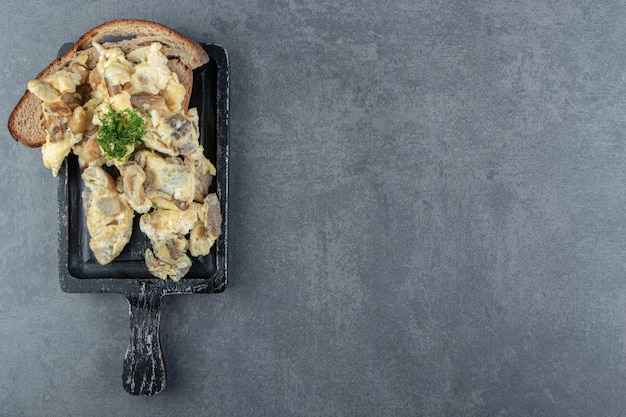Let's be honest, sometimes you just crave a simple, satisfying meal. And that's where chicken tenderloins come in. They're quick, versatile, and always seem to disappear in a flash. But achieving that perfect golden-brown crust, while keeping the inside juicy and tender, can be a real culinary balancing act. I've been there, staring down a pan of chicken tenderloins, wondering if I've cooked them too long or not long enough. Over the years, I've learned a few tricks to ensure that every time I pan-fry chicken tenderloins, they're absolutely perfect. So, grab your spatula, your favourite spices, and let's get cooking!
(Part 1) The Foundation: Prepping for Pan-Frying Success

Before we even think about the hot pan, we need to lay a strong foundation. The prep work is crucial for achieving that perfectly cooked, flavourful chicken.
1. Choosing Your Tenderloins: Quality Matters
I'm a firm believer in using fresh, high-quality ingredients. It makes all the difference in the final flavour. So, when you're at the butcher or the supermarket, take a close look at those tenderloins. You want them to be plump, firm, and have a nice, even colour, indicating freshness. Steer clear of any that look dry, discoloured, or have any odd smells. Remember, you want those tenderloins to be bursting with flavour, not just bland, watery pieces of meat.
2. Patting Them Dry: The Key to crispy skin
Once you've selected your tenderloins, give them a good pat down with some kitchen paper. We want to remove as much moisture as possible before they hit the pan. This step helps prevent steam from building up, which can lead to soggy chicken and hinder the browning process.
3. Seasoning for Flavour: A Simple, But Important Step
Now, this is where you can get creative and add your personal touch. A simple salt and pepper rub will always do the trick, but why stop there? I love to experiment with different spices, like paprika, garlic powder, or even a pinch of cayenne pepper for a bit of heat. The key is to create a flavourful crust that complements the chicken and gets your taste buds excited. Remember, the spices will infuse the chicken as it cooks, so don't be shy.
(Part 2) Mastering the Pan: The Art of Pan-Frying

Now we're getting to the heart of the matter. The pan-frying process is where your tenderloins will transform into a delicious meal.
1. Heating the Pan: Achieving that Sizzling Sound
Before you do anything else, make sure that pan is good and hot. I'm talking screaming hot. Use a heavy-bottomed skillet, ideally cast iron, and heat it over medium-high heat. This creates a searing effect that helps brown the tenderloins beautifully, giving them that irresistible crispy exterior. If you don't have a cast iron skillet, a good quality stainless steel pan will work just fine.
2. Adding the Fat: The Right Amount Makes All the Difference
Now, we need a little bit of fat to help the chicken cook evenly and prevent sticking. I usually go for a neutral oil, like vegetable oil or canola oil, but you can also use olive oil if you prefer. Just be mindful that olive oil has a lower smoke point, so don't let it get too hot. A tablespoon or two should be enough to coat the bottom of the pan.
3. cooking time: A Balancing Act
This is where things get a little tricky, as cooking time varies depending on the size and thickness of your chicken tenderloins. But, as a general rule of thumb, you'll want to cook them for about 3-4 minutes per side. You'll know they're ready when they're golden brown and cooked through. If you're unsure, use a meat thermometer to check for an internal temperature of 165°F (74°C).
4. Checking for Doneness: The No-Fail Method
You want your chicken tenderloins to be cooked through without being dry, so keep a close eye on them. A good way to check for doneness is to gently press on the surface of the tenderloin. If it springs back, it's cooked through. If it feels squishy, it needs a little more time. Another way to check is to cut into one of the tenderloins with a knife. The inside should be white and no longer pink.
(Part 3) Beyond the Pan: Finishing Touches for Perfection

You've just created a beautiful golden-brown crust, but there's more to achieving pan-fried chicken tenderloin perfection.
1. Resting is Key: Let the Juices Redistribute
After you take the chicken tenderloins out of the pan, let them rest for a few minutes before serving. This is a crucial step, as it allows the juices to redistribute throughout the meat, resulting in tender, succulent chicken. Don't be tempted to dig in right away, give them a little time to cool down and relax.
2. Sauce and Toppings: Amplify the Flavour
Now, this is where you can really let your creativity shine. Pan-fried chicken tenderloins are a blank canvas for all sorts of delicious sauces and toppings. You can go classic with a creamy garlic sauce, add a touch of tang with a lemon butter sauce, or even sprinkle on some fresh herbs for a lighter touch. The sky's the limit!
3. Serving Suggestions: A Variety of Options
Pan-fried chicken tenderloins are incredibly versatile. They're delicious on their own, served with a side of mashed potatoes, roasted vegetables, or a simple salad. Or, you can add them to your favourite dishes like sandwiches, wraps, or salads.
(Part 4) Troubleshooting: Avoiding Common Pan-Frying Mistakes
We all make mistakes in the kitchen, but with a little know-how, we can avoid some of the common pitfalls.
1. Overcrowding the Pan: Giving Chicken Space to Breathe
One of the biggest mistakes people make is overcrowding the pan. If you cram too many tenderloins in there, they won't cook evenly and they might end up steamed instead of seared. Give each tenderloin plenty of space to breathe and brown beautifully. It's better to cook in batches than to overcrowd the pan.
2. Not Using Enough Fat: The Secret to Even Cooking
Another common mistake is not using enough fat. You need enough to help the chicken cook evenly and prevent sticking. Don't be afraid to add a little extra oil if needed, especially if your pan isn't well-seasoned.
3. Cooking Over Too High Heat: Finding the Right Temperature
While you need a hot pan for searing, cooking over too high heat can lead to burnt chicken tenderloins. Make sure the heat is even and the chicken is cooking evenly. If it starts to burn, reduce the heat immediately.
4. Not Resting the Chicken: Patience is Key
Resist the urge to dig in right away! Resting the chicken allows the juices to redistribute, resulting in tender, succulent meat. Give them a few minutes to cool down and relax before you slice and serve.
(Part 5) Variations and Experimentation: Beyond the Basics
Once you've mastered the basics, it's time to get creative and experiment with different flavours and techniques.
1. Marinating the Chicken: Adding Depth of Flavour
For extra flavour, marinate your chicken tenderloins in a mixture of soy sauce, garlic, ginger, and honey before pan-frying. This will add a burst of umami flavour to your chicken. Let them marinate for at least 30 minutes, or even better, overnight for maximum flavour infusion.
2. Using Different Spices: A World of Flavours to Explore
Experiment with different spice blends to create unique flavour profiles. Try a Cajun spice rub, a Moroccan blend, or a blend of Italian herbs. The possibilities are endless! You can even create your own custom spice blend by combining your favourite spices.
3. Adding a Glaze: Finishing Touches for Added Flavor
Once your chicken tenderloins are pan-fried, you can brush them with a glaze to add an extra layer of flavour. Try a honey-soy glaze, a teriyaki glaze, or a maple-mustard glaze. You can even make your own glaze using ingredients like honey, soy sauce, ginger, and garlic.
4. Serving with Sides: Completing the Meal
Pair your pan-fried chicken tenderloins with different sides for a complete meal. Try a simple salad, a bed of rice, a side of roasted vegetables, or a creamy potato gratin. You can also experiment with different grains, like quinoa or couscous, for a healthy and flavorful option.
(Part 6) Chicken Tenderloin Adventures: Beyond Dinner
Chicken tenderloins are so versatile; they can be incorporated into a variety of meals and snacks.
1. Chicken Tenderloin Skewers: A Fun and Delicious Option
Thread pan-fried chicken tenderloins onto skewers with your favourite vegetables, like bell peppers, onions, and cherry tomatoes. You can even grill them for a smoky flavour. These skewers are perfect for a casual summer meal or a fun party appetizer.
2. Chicken Tenderloin Salads: Adding Protein and Flavor
Add pan-fried chicken tenderloins to your favourite salads for a protein boost. Combine them with greens, tomatoes, cucumbers, and a vinaigrette dressing for a satisfying and healthy meal. You can also add other ingredients like avocado, crumbled feta cheese, or toasted nuts for added texture and flavour.
3. Chicken Tenderloin Sandwiches: A Classic with a Twist
Create delicious sandwiches by layering pan-fried chicken tenderloins with your favourite toppings. Try them with toasted bread, mayonnaise, lettuce, tomato, and cheese. You can also add other ingredients like bacon, avocado, or a spicy sriracha mayo for a more adventurous flavour.
(Part 7) FAQs: Your Pan-Frying Questions Answered
Here are some common questions about pan-frying chicken tenderloins:
1. What if my Chicken Tenderloins Are Too Thin?
Don't worry! If your chicken tenderloins are too thin, you can cook them for a shorter amount of time. Aim for about 2-3 minutes per side, or until they're cooked through and golden brown. You can also try to cook them in a slightly cooler pan to prevent them from drying out.
2. Can I Pan-Fry frozen chicken Tenderloins?
It's not recommended to pan-fry frozen chicken tenderloins. They won't cook evenly and they'll likely end up dry and tough. It's best to thaw them completely in the refrigerator before pan-frying. If you're in a hurry, you can thaw them in a bowl of cold water, but make sure to change the water every 30 minutes.
3. How Can I Prevent My Chicken Tenderloins From Sticking to the Pan?
Use a well-seasoned cast iron skillet or a good quality stainless steel pan. Make sure the pan is hot enough before adding the chicken. Add a tablespoon or two of oil to the pan and swirl it around to coat the bottom. If you notice any sticking, you can try using a spatula to gently lift the chicken and release any stuck pieces.
4. What Temperature Should I Cook My Chicken Tenderloins To?
Cook your chicken tenderloins to an internal temperature of 165°F (74°C). This ensures that the chicken is cooked through and safe to eat.
5. Can I Use Other Oils Instead of Vegetable Oil?
Yes, you can use other oils like olive oil, canola oil, or avocado oil. Just make sure the oil has a high smoke point so it doesn't burn. Olive oil is a great choice for pan-frying chicken, but remember to use it sparingly and to heat the pan over medium-high heat.
(Part 8) Final Thoughts: A culinary adventure Awaits
Pan-frying chicken tenderloins is a simple and rewarding culinary adventure. With the right techniques and a little practice, you'll be able to create delicious, perfectly cooked chicken tenderloins every time. So, grab your spatula, get cooking, and enjoy the journey!
Everyone is watching

Corn on the Cob: The Ultimate Guide to Perfectly Cooked Ears
Healthy MealsAh, corn on the cob. Just the name evokes images of sunny days, barbecues, and that sweet, juicy flavour that ...

Scallops: The Ultimate Guide to Perfect Cooking
Healthy MealsAh, scallops. Those delicate, sweet, and utterly delicious morsels of the sea. They hold a special place in my...

Spaghetti Squash: The Ultimate Guide to Cooking and Serving
Healthy MealsRemember that time you saw spaghetti squash at the supermarket, looking all bumpy and strange, and thought, "W...

Salmon Cooking Times: Perfect Guide for Every Recipe
Healthy MealsLet me tell you, cooking salmon is an art form. It's all about getting that perfect balance: juicy and tender,...

Ham Cooking Time: How Long to Bake, Smoke, or Boil a Delicious Ham
Healthy MealsAh, ham. It's a classic, isn't it? A real crowd-pleaser, especially around holidays. And when done right, it'...
